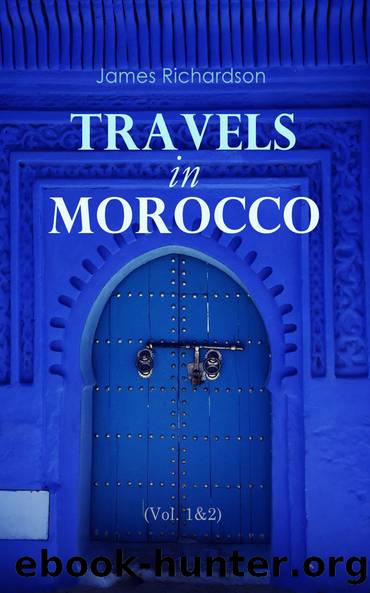Travels in Morocco, Volume 2. by James Richardson

Author:James Richardson [Richardson, James]
Language: eng
Format: epub
ISBN: 9781518790638
Barnesnoble:
Publisher: CreateSpace Publishing
Published: 2015-10-27T00:00:00+00:00
If two millions are deducted from this amount, perhaps the reader will have something like a probable estimate of the population of Morocco. It is hardly correct to classify Moors as mixed Arabs, many of them being simply descendants of the aboriginal Amazirghs. I am quite sure there are no Touaricks in the Empire of Morocco.
Of the Maroquine Sahara, I have only space to mention the interesting cluster of oases of Figheegh, or Figuiq. Shaw mentions them as "a knot of villagers," noted for their plantations of palm-trees, supplying the western province of Algeria with dates. We have now more ample information of Figheegh, finding this Saharan district to consist of an agglomeration of twelve villages, the more considerable of which are Maiz, counting eight hundred houses, El-Wadghir five hundred, and Zenega twelve hundred. The others vary from one or two hundred houses. The villages are more or less connected together, never farther apart than a quarter of a league, and placed on the descent of Wal-el-Khalouf ("river of the wild boar") whence water is procured for the gardens, containing varieties of fruit-trees and abundance of date-palms, all hedged round with prickly-pears. Madder-root and tobacco are also cultivated, besides barley sufficient for consumption. The wheat is brought from the Teli. The Wad-el-Khalouf is dry, except in winter, but its bed is bored with inexhaustible wells, whose waters are distributed among the gardens by means of a clepsydra, or a vessel which drops so much water in an hour. The ancients measured time by the dropping of water, like the falling of sand in the hour-glass.
Some of the houses in these villages have two stories, and are well built; each place has its mosque, its school, its kady, and its sheikh, and the whole agglomeration of oases is governed by a Sheikh Kebir, appointed by the Sultan of Morocco. These Saharan villages are eternally in strife with one another, and sometimes take up arms. On this account, they are surrounded by crenated walls, defended by towers solidly built. The immediate cause of discord here is water, that precious element of all life in the desert. But the imaginations of the people are not satisfied with this simple reason, and they are right, for the cause lies deeply in the human heart. They say, however, their ancestors were cursed by a Marabout, to punish them for their laxity in religion, and this was his anathema, "God make you, until the day of judgment, like wool-comber's cards, the one gnawing the other!"
Their wars, in fact, are most cruel, for they destroy the noble and fruitful palms, which, by a tacit convention, are spared in other parts of the Sahara when these quarrels proceed to bloodshed. They have, besides, great tact in mining, and their reputation as miners has been a long time established. But, happily, they are addicted to commerce and various branches of industry, as well as war, having commercial relations with Fez, Tafilett and Touat, and the people are, therefore, generally prosperous.
Download
This site does not store any files on its server. We only index and link to content provided by other sites. Please contact the content providers to delete copyright contents if any and email us, we'll remove relevant links or contents immediately.
1610396766 (N) by Jo Ann Jenkins(1298)
Whatever You Do, Don't Run by Peter Allison(1246)
Botswana--Culture Smart! by Michael Main(1238)
In Arabian Nights by Tahir Shah(1199)
Livingstone by Tim Jeal(1152)
The Old Farmer's Almanac 2020 by Old Farmer’s Almanac(1152)
Ubuntu by Ellis Heather;(1136)
The Templars by Michael Haag(1125)
Dead Eye by Mark Greaney(1106)
Africa: Altered States, Ordinary Miracles by Richard Dowden(1078)
Top 10 Israel and Petra by DK Travel(1070)
Morocco Travel Guide by Lonely Planet(1065)
Egypt Travel Guide by Lonely Planet(1055)
The Promise of a Pencil: How an Ordinary Person Can Create Extraordinary Change by Braun Adam(1055)
False Papers by André Aciman(1050)
First Comes Love, then Comes Malaria by Eve Brown-Waite(1042)
Jeff Corwin by Jeff Corwin(1030)
The Masked Rider by Neil Peart(987)
African Nights by Kuki Gallmann(966)
